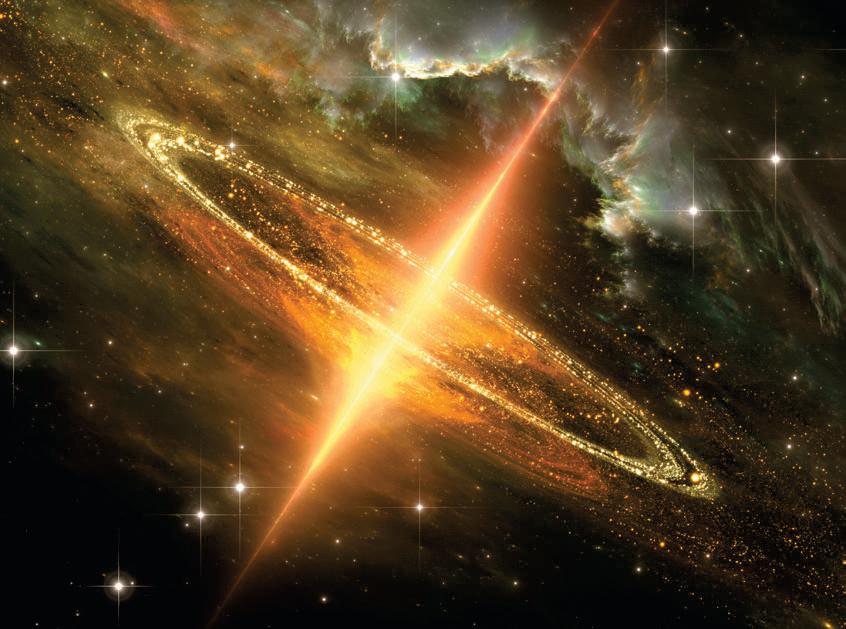Intentar ORO - Gratis
How Big Can Black Holes Get?
Scientific American
|December 2025
There may be an upper limit to their growth

Black holes like the one shown * in this illustration can grow astonishingly massive by feeding on immense amounts of matter.
IN THE EARLY 1960S ASTRONOMERS DISCOVERED a monster. Something in the constellation of Virgo was pouring out radio waves, but no counterpart in visible light was seen initially. After a lengthy effort, that changed when observers glimpsed a faint blue “star” sitting at the radio source’s exact position. Eventually they were able to determine that this object, called 3C 273, was not a star at all but rather something much stranger located a staggering two billion light-years from Earth.
To be visible across such a vast stretch of space, the “quasi-stellar object” (quasar for short) 3C 273 had to be overwhelmingly bright. Scientists ultimately settled on a feeding black hole at the heart of a far-distant galaxy as the most likely engine for 3C 273’s ridiculous luminosity. And it wasn’t just any black hole but a positively Brobdingnagian one, with a mass that was probably 900 million times that of our sun.
Since that time, we’ve found many more such supermassive black holes. In fact, by the 1980s astronomers were starting to suspect that every big galaxy had a supermassive black hole in its center. Thanks to observations from the Hubble Space Telescope and other facilities, we now know that is true—which means there could be as many as a trillion such giants in the observable universe.
And “supermassive” is definitely the right name for them. Many have been found with a billion times the sun’s mass, and the beefiest can be even heavier than that. This fact naturally raises the question: Just how hefty can one get?
Esta historia es de la edición December 2025 de Scientific American.
Suscríbete a Magzter GOLD para acceder a miles de historias premium seleccionadas y a más de 9000 revistas y periódicos.
¿Ya eres suscriptor? Iniciar sesión
MÁS HISTORIAS DE Scientific American
Scientific American
Will We Run Out of Rare Earth Elements?
These valuable but difficult-to-extract metals are increasingly important to modern life
1 mins
December 2025

Scientific American
Copyright Laws Can Stop Deepfakes
The U.S. should give its residents rights to their own face and voice
4 mins
December 2025

Scientific American
50, 100 & 150 Years
“The list of first-aid procedures that the medical profession encourages laypeople to undertake is short because of concern that tactics applied in ignorance may do more harm than good.
3 mins
December 2025

Scientific American
Dramatic Atmosphere
Exoplanet TOI-561 b has air where none should persist
2 mins
December 2025

Scientific American
The Mother of Depressions
Postpartum depression is a leading cause of death among new mothers. A new type of drug offers better, faster treatment
16 mins
December 2025

Scientific American
Going Rogue
A massive study may improve the prediction of dangerous rogue waves
3 mins
December 2025

Scientific American
Phages Caught Sleeping
Bacteria use hibernating viruses to immunize themselves
2 mins
December 2025
Scientific American
THE COVERT HERBARIUM OF CRYPTOGAMIC BOTANY
A century ago a father and a son labored to replicate the intricate structure of nearly eight hundred species of plants in four thousand delicate models.
1 min
December 2025

Scientific American
Are AI Chatbots Healthy for Teens?
Kids crave approval from their peers. Chatbots offer an alternative to real-life relationships, but they can come at a price
5 mins
December 2025

Scientific American
The Myth of the Designer Baby
Parents beware of any genomics firm saying it can help them with “genetic optimization” of their embryos
5 mins
December 2025
Listen
Translate
Change font size

